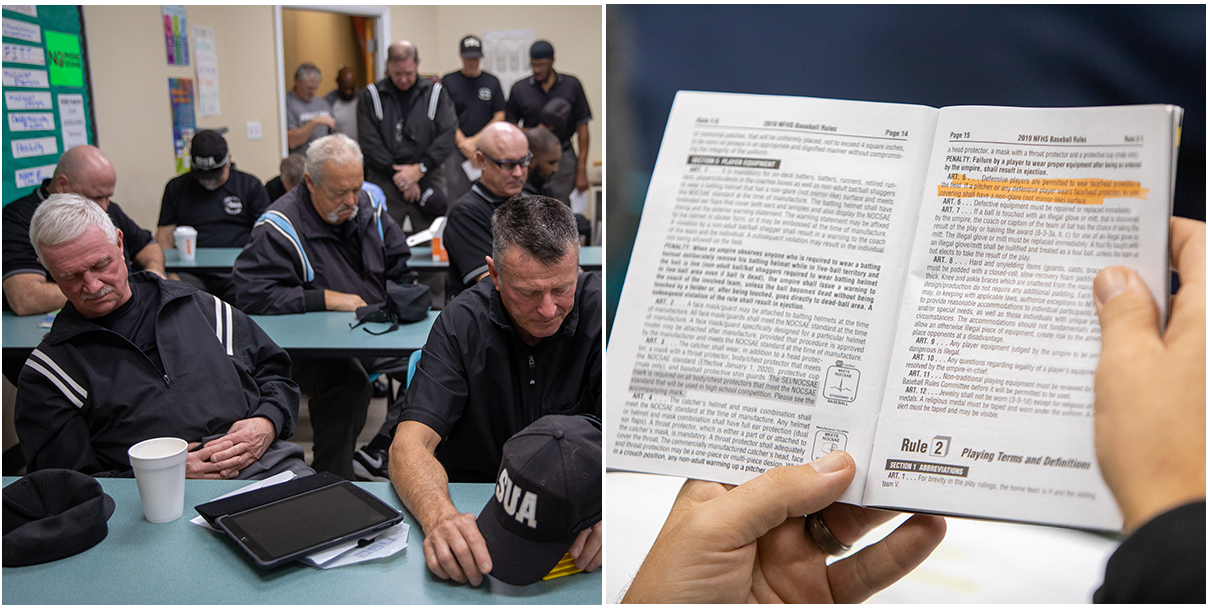Score Some Extra Cash as a Youth Baseball Umpire. Here’s How

Steve Banks can’t get any closer to the action, standing in the line of fire calling balls and strikes as a high school baseball umpire. “It’s the best seat in the house,” says Banks, 45, who has officiated at games part time since 1993.
The start of the high school and youth baseball seasons begin in late February and in March, and leagues across the nation need umpires. It’s a great way to get involved with sports and earn some extra money. Banks says umpires in his area make $40 to $70 per game officiating youth-level and high school baseball.
There’s a need for officials not just in baseball but in all sports, as states across the U.S. have reported shortages in recent years. Theresia Wynns, director of sports and officials with the National Federation of State High School Associations, says there are many contests across the country that need people to fill those slots.
“States are always looking for people who have a high interest and [are] willing to put in the time for training,” she says.
So if you’re looking for a side hustle and have a love for “America’s Pastime,” here’s what you need to know to become a part-time baseball umpire.
First, Find Your Local Umpire Association

Wynns recommends that aspiring officials contact their state high school athletic association, which will tell candidates how to reach local umpires in their area.
Umpire associations are regional groups that assign officials to baseball games from the youth level to high school. These groups help develop rookie officials.
During association meetings, senior umpires may informally test youth umpires by going over the rules of the game. This extra training is designed to better prepare the newbies for their next time on the field or to take the baseball rules exam, a requirement when joining their state’s high school athletic association. Each umpire must register with their state’s high school athletic association and pass a rules exam annually before they’re eligible to officiate a high school-level contest.
These groups also conduct field evaluations of the newer umpires by having them officiate youth team scrimmages. The evaluations help the association’s assigners determine which competition level each umpire can handle.
Equipment and Dues
When umpire Dave Stone meets an aspiring official, he wants to know why they want to become one, what their goals are and if they’ve ever done it before.
“The reason I want to know all those things is that baseball, unlike all the other sports, is probably the most expensive sport from an equipment standpoint to invest in,” says Stone, former president of the West Coast Umpires Association, which oversees baseball games in Hillsborough County, Florida. “I want to know how serious they are about it because there’s going to be an up-front cost.”
He says it can cost between $150 to $175 to buy a decent set of equipment, which includes a mask, chest protector, ball bag and shin guards. That total can jump up to $500 for top-of-the-line gear and uniforms. Luckily, some organizations help the young umpires by loaning out equipment from older umpires who are stepping away from officiating, Stone says.
Another added expense is the dues, which officials are required to pay to their local umpire and state high school athletic associations. Stone says his association dues are a flat fee of $55, but the cost can differ among umpire groups. In Florida, for example, umpires are also required to pay $45 annually to join the Florida High School Athletic Association and pass a yearly test to become and continue as a sports official. Once they pass, they can officiate at baseball games and have access to additional training materials and liability insurance.
What to Expect When Starting Out

Stone warns rookie umpires that it’s going to be awhile before they can officiate a high school game.
“You’re not going to see a high school game — in our organization, with no experience — probably for at least two to three years,” says Stone, 66, who has been umpiring since 1995.
During that time, he says, newbies can umpire youth league organizations such as Little League, Babe Ruth League, Ripken Baseball and Pony Baseball.
In addition to umpiring, Banks, a route developer for a dry cleaning company in St. Petersburg, Florida, also serves as training coordinator for the Suncoast Umpires Association. His association holds training sessions at each meeting and evaluates the younger umpires to determine which level of competition they’re ready to officiate.
What’s the Pay and Work Schedule?

Banks says “It’s all about reliability and availability” when it comes to scheduling and how much money you can make as an umpire. In sunny Florida, baseball is played on some level from spring until Thanksgiving.
Stone says youth league games typically take about an hour and 45 minutes to finish, and Banks says high school games can be a 2 1/2 hour commitment. According to Banks, umpires can make between $40 and $50 per game at the youth level and between $50 and $70 per game at the high school level.
Banks, who only works high school games, estimates working about 45 games during the spring season. Overall, he averages officiating two to four games per week throughout the year. “In this kind of gig economy, it’s an ideal job,” he says.
Matt Reinstetle is a staff writer at The Penny Hoarder. He writes about side hustles and the gig economy. If you have a story idea, send him a message on Twitter @MattReinstetle.
















